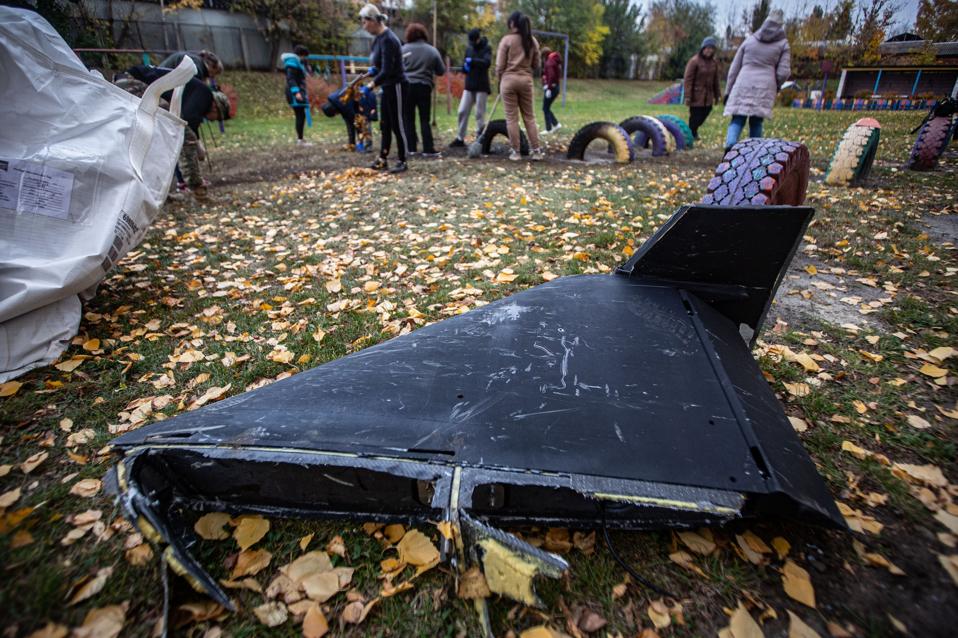
The wing of a Russian drone crashes into the courtyard of a preschool in Sumy. (Photo by Francisco Richart Barbeira/NurPhoto via Getty Images)
NurPhoto via Getty Images
Dispatches from Ukraine. Day 1,336.
Trump Pressures Zelenskyy to Accept Putin’s Terms
In a tense White House meeting on Friday, Oct. 17, U.S. President Donald Trump reportedly urged his Ukrainian counterpart Volodymyr Zelenskyy to accept Russia’s terms for ending the war, warning that Vladimir Putin had said he would “destroy” Ukraine if it refused. The encounter, described by officials as a “shouting match,” served to highlight the fluidity of Trump’s stance toward the conflict — and his readiness to mirror the Kremlin’s tone, which was additionally reinforced by his “lengthy” call with President Putin on Oct. 16.
President Zelenskyy arrived in Washington in hopes of securing long-range Tomahawk cruise missiles, which would put Moscow in Kyiv’s crosshairs; however, Trump declined the request, albeit not with a direct refusal, but by saying that Washington has only a limited number of such missiles at its disposal. Instead, the discussion devolved into a heated exchange similar to one earlier this year, when Trump and Vice President JD Vance berated Zelenskyy for a lack of gratitude toward Washington and the aid it has provided to Ukraine since Russia’s invasion.
According to a European official with knowledge of the meeting, Trump told Zelenskyy that President Putin described the conflict as a “special operation, not even a war.” The claim that Russia is not waging the war at full strength aligns closely with the Russian narrative, intended to justify its military setbacks. In reality, Moscow is deploying nearly its entire conventional arsenal, except nuclear weapons. In addition to asserting that Russia’s economy was “doing great,” Trump also warned Zelenskyy, “If [Putin] wants it, he will destroy you.”
Sources familiar with the meeting said President Trump “cursed all the time,” tossed aside maps of the Ukrainian front line, and even insisted that Zelenskyy surrender the entire Donbas region in eastern Ukraine to Moscow, as Putin insists.
Donbas, a historic region in eastern Ukraine, comprises Donetsk and Luhansk provinces, where war with Russian-backed proxies has been raging since spring 2014, following illegal referendums conducted by local authorities seeking independence from Kyiv. To date, Russian forces control roughly three quarters of Donetsk and almost all of Luhansk, which was swiftly seized in the first months of the full-scale invasion in 2022.
Russia’s latest offensive in Ukraine has yielded minimal territorial gains despite significant human and material costs. According to an analysis by British weekly The Economist, satellite and open-source data suggest that Russia’s summer offensive captured just 0.4% of Ukrainian land. At the current pace, seizing the remaining portions of the four regions enshrined in the Russian constitution since late 2022 (Donetsk, Luhansk, Kherson, and Zaporizhzhia) would take until June 2030; a full occupation of Ukraine, in turn, would require more than a century, or an astonishing 103 years.
Ukraine’s Interceptor Drones
On Oct. 20, Ukrainian FPV-drone manufacturer General Chereshnya (also known as “General Cherry”) said it has begun serial production of its anti-Shahed interceptor drone, called the “General Cherry Bullet.” The company builds the “Bullet” in night, day and terminal-guidance versions and says the drone can reach a top speed of 190 miles per hour, giving it the “maneuverability and speed” to catch fast, agile targets. Company communications say the system passed tests and is ready for mass production. Developers note the “Bullet” has been used to intercept Russian Shaheds, claiming it destroyed more than 20 in the past two months.
The cost of the “Bullet” has not been officially released, however estimates by industry insiders put it at little over $2,000 per unit. General Cherry reports producing 50,000 drones a month and posted roughly $35 million in revenue in the first half of 2025; by contrast, outside sources describe more modest production measured in the “thousands per month” range.
Previously, President Zelenskyy said Ukraine’s “interceptor drones” have a 68% interception rate. In an interview on Oct. 12, he called them “the most cost-effective way” to neutralize Russian Shahed drones, which flood Ukrainian skies night after night. He noted that production capacity remains constrained by lack of capital to fund expansion and an estimated cost of $3,000–$5,000 per drone.
Russian Attacks on Ukraine
Ukrainian regional officials reported seven people killed and at least 86 others injured in Russian strikes between Oct. 17 and 20. In southern Kherson oblast, or province, two people were killed and 22 others wounded. In the eastern Donetsk region, two residents lost their lives and 18 were wounded. In bordering Zaporizhzhia oblast, eight people were injured, while in Dnipropetrovsk, 14 civilians were wounded. In northeastern Kharkiv province, three individuals were killed and 24 others injured.
By Danylo Nosov, Karina L. Tahiliani

